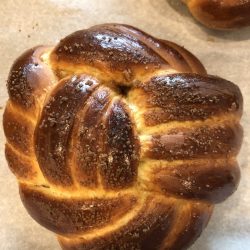STEVEN’S SWEET CHOCOLATE & CINNAMON KNOTS
These Winston-knot bread rolls are made by braiding together three strands of a soft, sweet enriched dough – filled with dark chocolate and cinnamon sugar.
Servings: 8 servings
Ingredients
For the dough:
- 500 g strong white bread flour plus extra for dusting (Bread Flour)
- 5 g fast-action dried yeast from a 7g sachet (Instant)
- 60 g unsalted butter softened, diced
- 40 g caster sugar granulated sugar
- 7 g salt
- 2 medium eggs at room temperature, beaten
- About 225ml full-fat milk lukewarm (whole milk)
For the filling:
- 50 g dark chocolate broken into chunks
- 4 tsp light muscovado sugar sub light brown sugar
- 1 tsp ground cinnamon
- 1 medium egg beaten, for glazing, use any size egg
Instructions
- Step 1 To make the dough: weigh the flour into a large mixing bowl, or the bowl of a stand mixer, and mix in the yeast with your hand. When thoroughly combined, add the butter and rub into the flour with the tips of your fingers until the mixture resembles fine crumbs. Mix in the sugar and salt then make a well in the centre of the mixture.
- Step 2 Pour the beaten eggs and 3⁄4 of the lukewarm milk into the well. Using your hands or the dough hook attachment of the mixer on its slowest speed, gradually work the flour into the liquids to make a soft but not sticky dough – slowly adding as much of the remaining milk as needed.
- Step 3 Knead the dough thoroughly – for 10 minutes by hand on a lightly floured worktop, or for 7 minutes if using the dough hook (on its slowest speed) – until very smooth and elastic. Return the dough to the bowl (if you kneaded by hand) then cover with cling film or a snap-on lid and leave on the worktop to prove for about an hour or until doubled in size.
- Step 4 Uncover then punch down the risen dough with your knuckles to deflate it. Turn out onto the worktop, very lightly dusted with flour, and knead into a ball. Then weigh the dough and divide into 4 equal portions. Cover 3 portions loosely with cling film and divide the other portion into 6 equal pieces. Using your hands, roll each piece on the worktop into a neat, even sausage 12.5 inches long. Try to use as little extra flour as possible for dusting your hands and the worktop – adding too much extra flour will make the dough tough and dry.
- Step 5 To shape the Winston knots: arrange 3 sausages of dough in a line on the worktop in front of you – at a minus 45-degree angle and fairly close together. Gently pinch the 3 together in the middle. Now place the other 3 strands on top at a 45-degree angle – to form an ‘X’ shape – and pinch together in the middle as before. Fold the 3 strands at the top left down over the centre point and onto the worktop – to the far right of the strands already there. Gently shuffle the 3 strands at the top right downwards so they sit alongside the other strands.
- Step 6 Arrange the 4 sets of strands closer together so they are lying side by side and slightly apart, so you can plait them. Pass the set on the far left under the 2 middle ones then back over the last one it went under and into line again. Then take the far-right set and put it under the twisted 2 in the middle then back over the last one it went under and into line.
- Step 7 Flip the knot over on the worktop. Scatter a quarter of the chocolate chunks down the centre of the knot. Mix the sugar with the cinnamon and sprinkle a quarter on top of the chocolate. Bring the long ends of the plait up and over the filling and pinch them together, then gently fold in the sides (try to keep the plait as neat as possible) and pinch the dough together to seal in the filling. Turn the plait over again, right side up, and gently shape into a neat ball with your hands. Transfer to the lined baking sheet.
- Step 8 Repeat with the other 3 portions of dough to make 4 neatly plaited round loaves – these knots take a lot of practise and patience to get right! Set them well apart on the baking sheet, slip the sheet inside a large plastic bag and slightly inflate the bag so the plastic doesn’t stick to the dough. Leave on the worktop to prove for about 1 hour, until doubled in size – take care not to over-prove the dough, or let the temperature become too hot, as the breads will lose their shape. Towards the end of the rising time, heat the oven to 425°F
- Step 9 Uncover the loaves and carefully brush with beaten egg to glaze. Bake in the heated oven for about 20–23 minutes until a good golden brown. Transfer to a wire rack and leave to cool.
